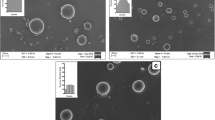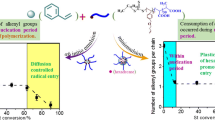Abstract
Three types of well-defined stabilizers, based on 2-dimethylaminoethyl methacrylate (DMAEMA), including poly(2-dimethylaminoethyl methacrylate) (PDMAEMA), poly(2-dimethylaminoethyl methacrylate)-block-poly(methyl methacrylate) (PDMAEMA-b-PMMA), and PDMAEMA-co-PMMA, were synthesized through reversible addition-fragmentation chain transfer (RAFT) solution polymerization and used as well-defined cationic stabilizers in emulsion (co)polymerization of styrene and/or methyl methacrylate (MMA). Because of different characteristics of MMA and styrene, using varying ratios of these monomer as well as using different structures of stabilizers allowed us to better understanding of stabilizers’ behavior during polymerization course. The results showed that PDMAEMA-b-PMMA was more robust against changes in monomer composition, meaning less fluctuations in particle size distribution and kinetics plots. Also, more than 85% monomer conversion was reached and the resulting polymer particles, ranging in diameter from 75 to ~135 nm. Using PDMAEMA-b-PMMA and adding only 5 mol% MMA as a comonomer in emulsion polymerization of styrene resulted in producing highly uniform particles with size polydispersity of (0.04), as confirmed by TEM and DLS. This narrow size polydispersity was attributed to generation of more positively charged amphiphilic oligomers at early stages of polymerization and thus, faster nucleation.
Graphical abstract






Similar content being viewed by others
Availability of data and materials
Not applicable
Code availability
Not applicable
References
El-Aasser MS, Sudol ED (1997) Emulsion polymerization and emulsion polymers. Wiley
Warson H (1996) Emulsion polymerization, a mechanistic approach. R. G. Gilbert. Academic Press, London, 1995. Polym Int 41:352. https://doi.org/10.1002/pi.1996.210410321
Cunningham M (2008) Cunningham, M. F. Controlled/living radical polymerization in aqueous dispersed systems. Prog. Polym. Sci. 33, 365-398. Prog Polym Sci 33:365–398. https://doi.org/10.1016/j.progpolymsci.2007.11.002
Bard AJ, Faulkner LR (2000) Electrochemical methods: fundamentals and applications. Wiley, p 850
Ho J, Mudraboyina B, Spence-Elder C, Resendes R, Cunningham MF, Jessop PG (2018) Water-borne coatings that share the mechanism of action of oil-based coatings. Green Chem 20:1899–1905. https://doi.org/10.1039/C8GC00130H
Zhang Y, Cunningham MF, Dubé MA (2020) Modification of adhesive and latex properties for starch nanoparticle-based pressure sensitive adhesives. Macromol React Eng 14:1900023. https://doi.org/10.1002/mren.201900023
Zhao CL, Holl Y, Pith T, Lambla M (1987) FTIR-ATR spectroscopic determination of the distribution of surfactants in latex films. Colloid Polym Sci 265:823–829. https://doi.org/10.1007/BF01418459
Roulstone BJ, Wilkinson MC, Hearn J (1992) Studies on polymer latex films: II. Effect of surfactants on the water vapour permeability of polymer latex films. Polym Int 27:43–50. https://doi.org/10.1002/pi.4990270107
Halperin A (1987) Polymeric micelles: a star model. Macromolecules 20:2943–2946. https://doi.org/10.1021/ma00177a051
Matyjaszewski K (2009) Controlled/living radical polymerization: progress in RAFT, DT, NMP & OMRP. American Chemical Society
Becher P (1993) A review of: “polymeric surfactants”, I. Piirma. Marcel Dekker, Inc. J Dispers Sci Technol 14:129–130. https://doi.org/10.1080/01932699308943391
Raffa P, Wever DAZ, Picchioni F, Broekhuis AA (2015) Polymeric surfactants: synthesis, properties, and links to applications. Chem Rev 115:8504–8563. https://doi.org/10.1021/cr500129h
dos Santos AM, Pohn J, Lansalot M, D’Agosto F (2007) Combining steric and electrostatic stabilization using hydrophilic macroRAFT agents in an ab initio emulsion polymerization of styrene. Macromol Rapid Commun 28:1325–1332. https://doi.org/10.1002/marc.200700146
Manguian M, Save M, Charleux B (2006) Batch emulsion polymerization of styrene stabilized by a hydrophilic macro-RAFT agent. Macromol Rapid Commun 27:399–404. https://doi.org/10.1002/marc.200500807
Ni P, Zhang M, Ma L, Fu S (2006) Poly(dimethylamino)ethyl methacrylate for use as a surfactant in the miniemulsion polymerization of styrene. Langmuir 22:6016–6023. https://doi.org/10.1021/la053276z
Wang X, Sudol ED, El-Aasser MS (2001) Emulsion polymerization of styrene using a reactive surfactant and its polymeric counterpart: kinetic studies. Macromolecules 34:7715–7723. https://doi.org/10.1021/ma0107298
Cochin D, Laschewsky A, Nallet F (1997) Emulsion polymerization of styrene using conventional, polymerizable, and polymeric surfactants. A Comparative Study. Macromolecules 30:2278–2287. https://doi.org/10.1021/ma9614510
Tauer K, Zimmermann A, Schlaad H (2002) New reactive block copolymers as stabilizers in emulsion polymerization. Macromol Chem Phys 203:319–327
Tadros TF (2017) Polymeric surfactants. De Gruyter, Berlin, Boston
Ayoub MMH, Nasr HE, Rozik NN (1998) Amphiphatic copolymer as surfactant for emulsion polymerization of styrene. J Macromol Sci Part A 35:1415–1432. https://doi.org/10.1080/10601329808002129
Shieh Y-T, Yeh Y-C, Cheng C-C (2020) Two-way CO2-responsive polymer particles with controllable amphiphilic properties. ACS Omega 5:1862–1869. https://doi.org/10.1021/acsomega.9b03319
Chiefari J, Chong YK(B), Ercole F et al (1998) Living free-radical polymerization by reversible addition−fragmentation chain transfer: the RAFT process. Macromolecules 31:5559–5562
Lowe AB, McCormick CL (2007) Reversible addition–fragmentation chain transfer (RAFT) radical polymerization and the synthesis of water-soluble (co)polymers under homogeneous conditions in organic and aqueous media. Prog Polym Sci 32:283–351. https://doi.org/10.1016/j.progpolymsci.2006.11.003
McCormick CL, Lowe AB (2004) Aqueous RAFT polymerization: recent developments in synthesis of functional water-soluble (co)polymers with controlled structures. Acc Chem Res 37:312–325. https://doi.org/10.1021/ar0302484
Zhang Q, Yu G, Wang W-J, Yuan H, Li BG, Zhu S (2013) Switchable block copolymer surfactants for preparation of reversibly coagulatable and redispersible poly(methyl methacrylate) latexes. Macromolecules 46:1261–1267
Shirin-abadi AR, Darabi A, Jessop PG et al (2016) Tuning the aggregation and redispersion behavior of CO2-switchable latexes by a combination of DMAEMA and PDMAEMA-b-PMMA as stabilizing moieties. Polymer (Guildf) 106:303–312
Xiao G, Hu Z, Zeng G, Wang Y, Huang Y, Hong X, Xia B, Zhang G (2012) Effect of hydrophilic chain length on the aqueous solution behavior of block amphiphilic copolymers PMMA-b-PDMAEMA. J Appl Polym Sci 124:202–208. https://doi.org/10.1002/app.33734
Tebaldi ML, Leal DA, Montoro SR, Petzhold C (2014) Synthesis of stimuli-sensitive copolymers by RAFT polymerization: potential candidates as drug delivery systems. Mater Res 17:191–196
Leemans L, Fayt R, Teyssie P, De Jaeger NC (1991) Poly(alkyl methacrylate-b-sulfonated glycidyl methacrylate). A new amphiphilic polymeric surfactant for the preparation and stabilization of polymer acrylic latices in aqueous medium. Macromolecules 24:5922–5925. https://doi.org/10.1021/ma00022a005
Tadros TF, Vincent B (1980) Influence of temperature and electrolytes on the adsorption of poly(ethylene oxide)-poly(propylene oxide) block copolymer on polystyrene latex and on the stability of the polymer-coated particles. J Phys Chem 84:1575–1580. https://doi.org/10.1021/j100449a028
Porter MR (1991) Polymeric surfactants BT - handbook of surfactants. In: Porter MR (ed). Springer US, Boston, pp 209–211
Beuermann S, Buback M, Davis TP, Gilbert RG, Hutchinson RA, Kajiwara A, Klumperman B, Russell GT (2000) Critically evaluated rate coefficients for free-radical polymerization, 3. Propagation rate coefficients for alkyl methacrylates. Macromol Chem Phys 201:1355–1364
Shirin-Abadi AR, Darabi A, Jessop PG, Cunningham MF (2015) Preparation of redispersible polymer latexes using cationic stabilizers based on 2-dimethylaminoethyl methacrylate hydrochloride and 2,2′-azobis[2-(2-imidazolin-2-yl)propane]dihydrochloride. Polymer (Guildf) 60:1–8
Su X, Jessop PG, Cunningham MF (2012) Surfactant-free polymerization forming switchable latexes that Can Be aggregated and redispersed by CO2 removal and then readdition. Macromolecules 45:666–670
Zhang W, D’Agosto F, Boyron O, Rieger J, Charleux B (2011) One-Pot synthesis of poly(methacrylic acid-co-poly(ethylene oxide) methyl ether methacrylate)-b-polystyrene amphiphilic block copolymers and their self-assemblies in water via RAFT-mediated radical emulsion polymerization. A kinetic study. Macromolecules 44:7584–7593. https://doi.org/10.1021/ma201515n
Zhang W, D’Agosto F, Boyron O, Rieger J, Charleux B (2012) Toward a better understanding of the parameters that lead to the formation of nonspherical polystyrene particles via RAFT-mediated One-Pot aqueous emulsion polymerization. Macromolecules 45:4075–4084. https://doi.org/10.1021/ma300596f
Pei Y, Lowe AB, Roth PJ (2017) Stimulus-responsive nanoparticles and associated (reversible) polymorphism via polymerization induced self-assembly (PISA). Macromol Rapid Commun 38:1600528. https://doi.org/10.1002/marc.201600528
Penfold NJW, Yeow J, Boyer C, Armes SP (2019) Emerging trends in polymerization-induced self-assembly. ACS Macro Lett 8:1029–1054. https://doi.org/10.1021/acsmacrolett.9b00464
Funding
Not applicable.
Author information
Authors and Affiliations
Contributions
Not applicable.
Corresponding author
Ethics declarations
Competing interests
The authors declare no competing interests.
Additional information
Publisher’s note
Springer Nature remains neutral with regard to jurisdictional claims in published maps and institutional affiliations.
Rights and permissions
About this article
Cite this article
Ramezanpour, M., Rezaee Shirin-Abadi, A. Emulsion polymerization using three types of RAFT prepared well-defined cationic polymeric stabilizers based on 2-dimethylaminoethyl methacrylate (DMAEMA): a comparative study. Colloid Polym Sci 299, 1189–1198 (2021). https://doi.org/10.1007/s00396-021-04836-3
Received:
Revised:
Accepted:
Published:
Issue Date:
DOI: https://doi.org/10.1007/s00396-021-04836-3




